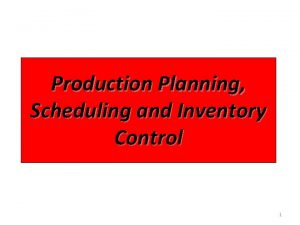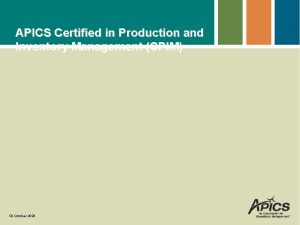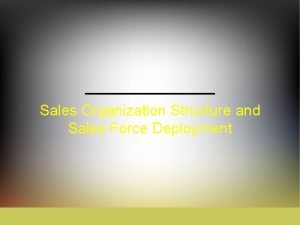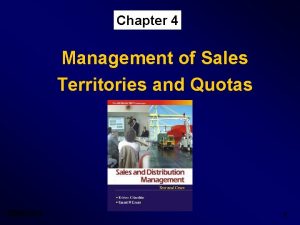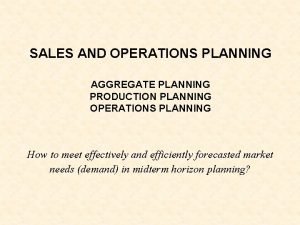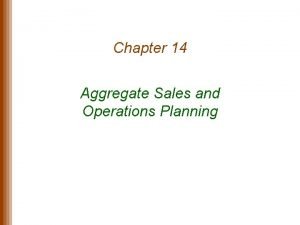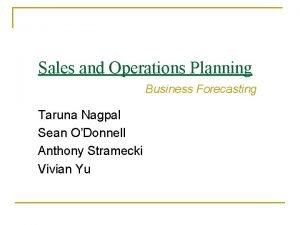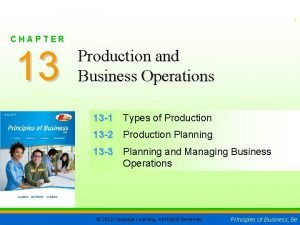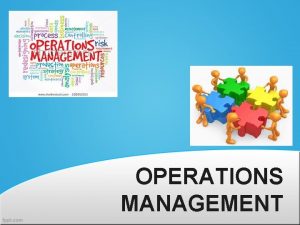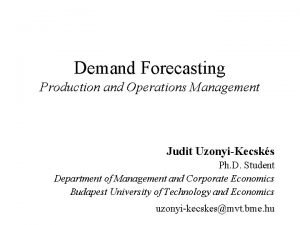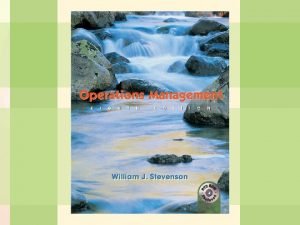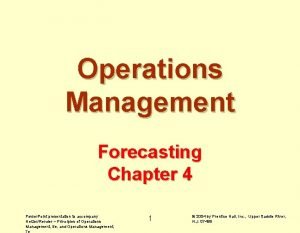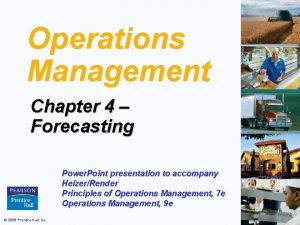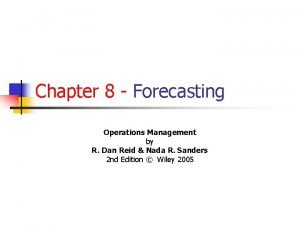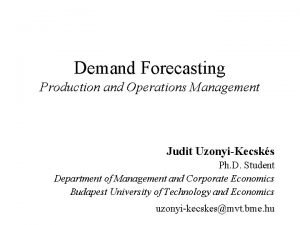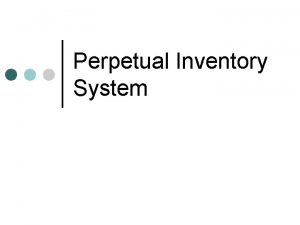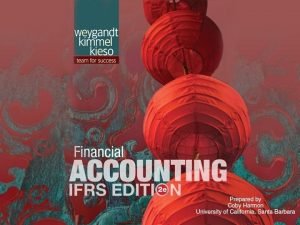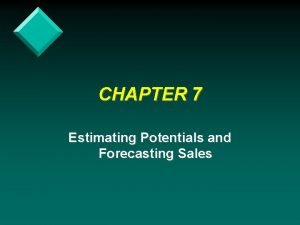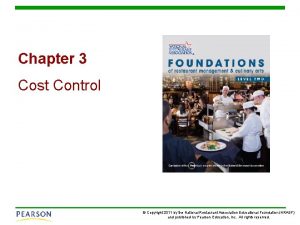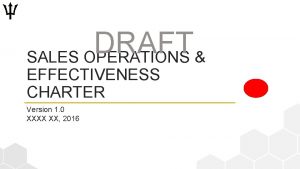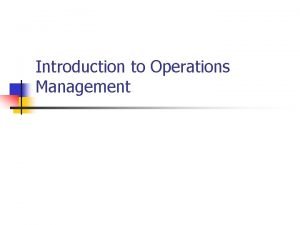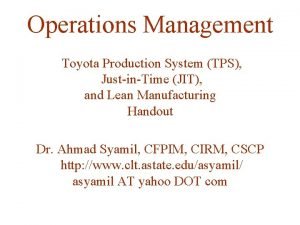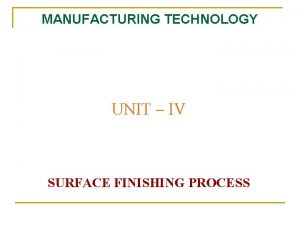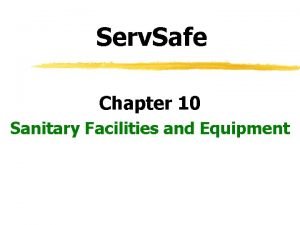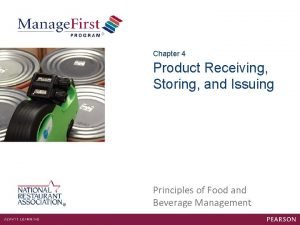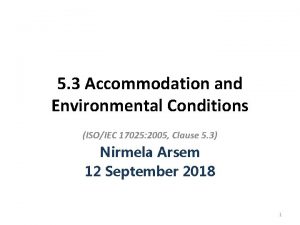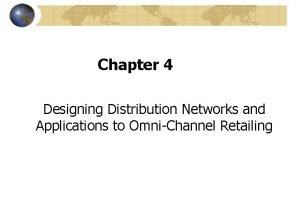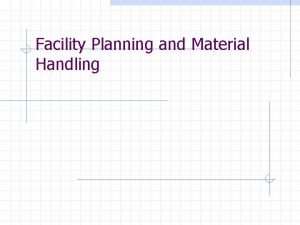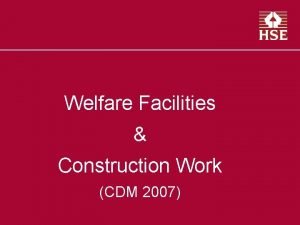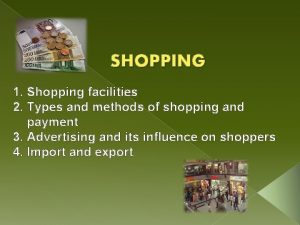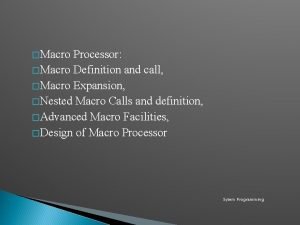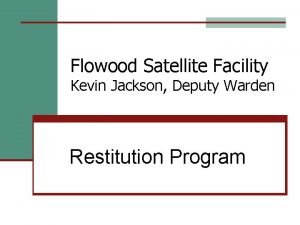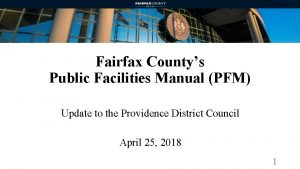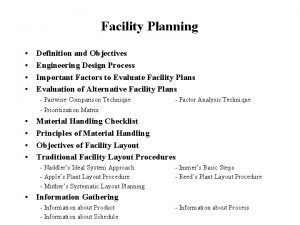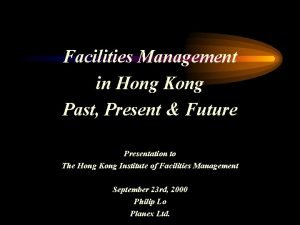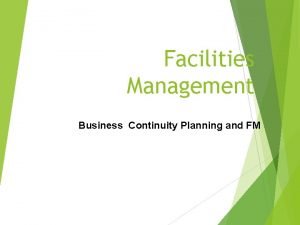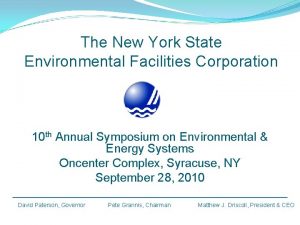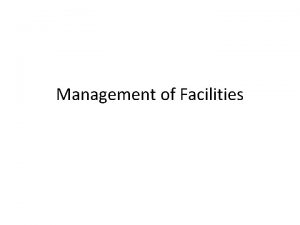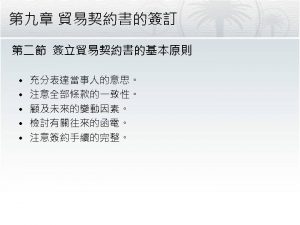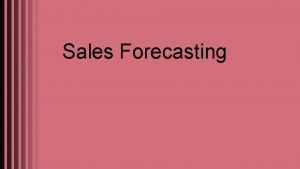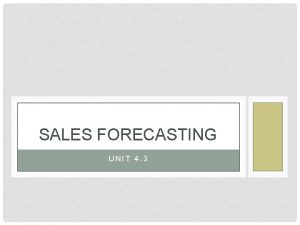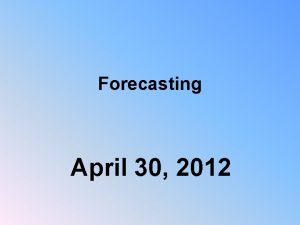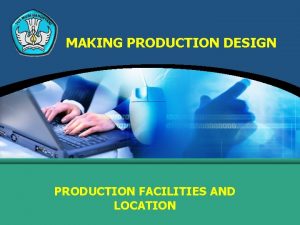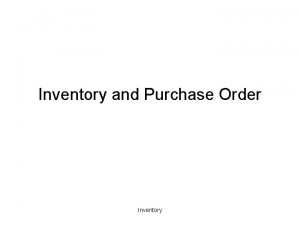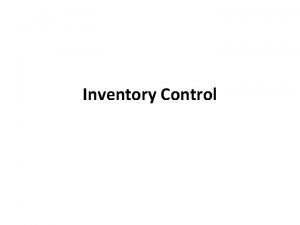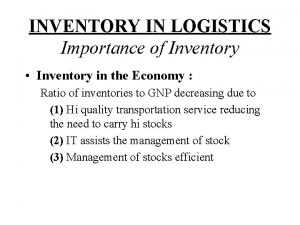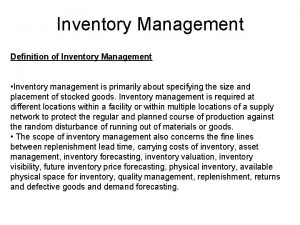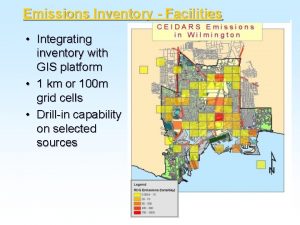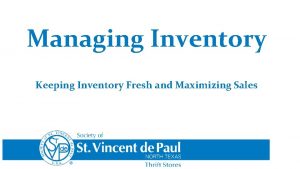Forecasting Forecasting and Operations Sales Production Inventory Facilities


























































- Slides: 58

Forecasting

Forecasting and Operations • • Sales Production Inventory Facilities Raw Materials People Profits Products

Forecasting Importance • Boeing, 1997: $2. 6 billion write down due to “raw material shortages, internal and supplier parts shortages” Wall Street Journal, Oct 23, 1997 • “IBM sells out new Aetna PC; shortage may cost millions in potential revenue. ” Wall Street Journal, Oct 7, 1994 • 2008 Daytona 500 – new sponsor – out of stock • Empty shelves

Principles of Forecasting •

Impacts of Forecasting • Forecasting errors can increase the total cost of ownership for a product inventory carrying costs - obsolete inventory - lack of sufficient inventory - quality of products due to accepting marginal products to prevent stockout - expediting costs

Forecasting • Essential for smooth operations of business organizations • Estimates of the occurrence, timing, or magnitude of uncertain future events • Costs of forecasting: excess labor; excess materials; expediting costs; lost revenues • Cabela’s – fishing rods

Demand Behavior ü Trend ü gradual, long-term up or down movement ü Cycle ü up & down movement repeating over long time frame ü Seasonal pattern ü periodic oscillation in demand which repeats ü Random movements follow no pattern

Forecasting Methods ü Time series ü Regression or causal modeling ü Qualitative methods ü Management judgment, expertise, opinion ü Use management, marketing, purchasing, engineering ü Delphi method ü Solicit forecasts from experts

Time Series Methods ü Statistical methods using historical data ü Moving average ü Exponential smoothing ü Linear trend line ü Assume patterns will repeat ü Naive forecasts ü Forecast = data from last period

Moving Average ü Average several periods of data Sum of Demand ü Dampen, smooth out In n Periods changes n ü Use when demand is stable with no trend or seasonal pattern

Simple Moving Average MONTH Jan Feb Mar Apr May June July Aug Sept Oct ORDERS PER MONTH 120 90 100 75 110 50 75 130 110 90

Simple Moving Average MONTH Jan Feb Mar Apr May June July Aug Sept Oct ORDERS PER MONTH 120 90 100 75 110 50 75 130 110 90 Daug+Dsep+Doct MAnov = 3 90 + 110 + 130 = 3 = 110 orders for Nov

Simple Moving Average MONTH Jan Feb Mar Apr May June July Aug Sept Oct Nov ORDERS THREE-MONTH PER MONTH MOVING AVERAGE 120 90 100 75 110 50 75 130 110 90 – – 103. 3 88. 3 95. 0 78. 3 85. 0 105. 0 110. 0

Simple Moving Average MONTH Jan Feb Mar Apr May June July Aug Sept Oct Nov ORDERS THREE-MONTH PER MONTH MOVING AVERAGE 120 90 100 75 110 50 75 130 110 90 – – 103. 3 88. 3 95. 0 78. 3 85. 0 105. 0 110. 0 FIVE-MONTH MOVING AVERAGE – – – 99. 0 85. 0 82. 0 88. 0 95. 0 91. 0

Weighted Moving Average ü Adjusts moving average method to more closely reflect data fluctuations

Weighted Moving Average Example MONTH August September October WEIGHT DATA 17% 33% 50% 130 110 90 Where do the weights come from?

Weighted Moving Average Example MONTH August September October WEIGHT DATA 17% 33% 50% 130 110 90 3 November forecast WMA 3 = Wi Di i=1 = (0. 50)(90) + (0. 33)(110) + (0. 17)(130) = 103. 4 orders 3 Month = 110 5 month = 91

Exponential Smoothing ü Averaging method ü Weights most recent data more strongly ü Reacts more to recent changes ü Widely used, accurate method Ft +1 = Dt + (1 - )Ft where Ft +1 = forecast for next period Dt = actual demand for present period Ft = previously determined forecast for present period = weighting factor, smoothing constant

Forecast for Next Period • Forecast = (weighting factor)x(actual demand for period)+(1 -weighting factor)x(previously determined forecast for present period) Lesser reaction to recent demand 0 > <= 1 Greater reaction to recent demand

Exponential Smoothing PERIOD MONTH DEMAND 1 2 3 4 5 6 7 8 9 10 11 12 Jan Feb Mar Apr May Jun Jul Aug Sep Oct Nov Dec 37 40 41 37 45 50 43 47 56 52 55 54

Exponential Smoothing Made Simple – 4 steps© • Step 1: First Period Forecasted = Naïve Forecast • Step 2: Remaining Periods Forecasted: (Smoothing Factor (ά) x Previous Actual Demand) • Step 3: Remaining Periods Forecasted: (1 Smoothing Factor(ά) x Previous Forecast) • Step 4: Remaining Periods Forecasted: Add Steps 2 and 3 © Joe Walden, 2011

Forecast Accuracy ü Find a method which minimizes error ü Error = Actual - Forecast ü Mean Absolute Deviation (MAD)

Forecast Control Why is my forecast out of tolerance? ü Reasons for out-of-control forecasts ü Change in trend ü Appearance of cycle ü Weather changes ü Promotions ü Competition ü Politics

Inventory Management

Inventory Management • What to order • When to order • How much to order

Types of Inventory ü Raw materials ü Purchased parts and supplies ü Labor ü In-process (partially completed) products ü Component parts ü Working capital ü Tools, machinery, and equipment ü Safety stock ü Just-in-case

Inventory Management • What is Inventory? • satisfy normal demand patterns • Inventory management – Decisions drive other logistics activities – Different functional areas have different inventory objectives – Inventory costs are important to consider • Inventory turnover • Inventory carrying costs

Purposes of Inventory • Enables the firm to achieve economies of scale • Balances supply and demand • Enables specialization in manufacturing • Provides protection from uncertainties in demand order cycle • Acts as a buffer between critical interfaces within the supply chain • Cover up inefficiencies in operations • Smooth variances in customer demand • An Addiction

Inventory Management Philosophies • Pull • Push • Just-in-time

Inventory-Related Costs • Inventory carrying (holding) costs – – – – Obsolescence Inventory shrinkage Storage costs Handling costs Insurance costs Taxes Interest charges Opportunity cost • Stockouts

Costs Relevant to Inventory Management • Carrying costs -Cost for holding the inventory over time -The primary cost is the cost of money tied up in inventory, but also includes obsolescence, insurance, personal property taxes, and storage costs -Typically, costs range from the cost of short term capital to about 40%/year. The average is about 25%/year of the item value in inventory.

Goals of inventory management

When to Order • Reorder point (ROP) ROP = DD x RC under certainty ROP = (DD x RC) + SS under uncertainty Where DD = daily demand RC = length of replenishment cycle SS = safety stock

Forms of Reorder Points • • Fixed Variable Two Bin Card Judgmental Projected shortfall Min-Max

Inventory Management Questions: • 3 questions: • EOQ developed by Fred Harris - 1913; made popular by R. H. Wilson

How Much to Reorder • Economic order quantity (EOQ) in dollars EOQ = √ 2 AB/C Where EOQ = the most economic order size, in dollars A = annual usage, in dollars B = administrative costs per order of placing the order C = carrying costs of the inventory (%)

Basic EOQ Model Assumptions 1. Constant known demand rate 2. Cost per unit not depend on order quantity (no quantity discounts) 3. Entire order delivered at one time 4. Ordering and carrying cost known and independent 5. No stock-out because of certain demand So What?

EOQ Example Annual Usage = 45, 000 units Ordering costs = $30 per order Carrying costs = 20% # ORDERS/YEAR = A/Q = 45, 000/3674 = 12. 25

Inventory Flows • Safety stock can prevent against problem areas • When fixed order quantity system is used, time between orders may vary • When reorder point is reached, fixed order quantity is ordered

Inventory Turns • What is it? • How is it calculated? • Why is it important?

Aggregate Performance Measure • Average Inventory Investment: It is the dollar value of a company’s average level of inventory. Disadvantage: It makes comparisons of companies difficult. • Inventory Turn Over Ratio: It is a measure that allows for better comparison among companies. Inventory Turnover = Annual cost of good sold Average Inventory Investment Disadvantage: Figures among industry may not be comparable.

ABC Analysis • Pareto’s Law – meaningful few and trivial many • 80/20 – based on Pareto’s analysis 80 percent of the wealth was in 20 percent of the people’s hands – in inventory management usually 20 percent of your items account for 80 percent of your inventory dollars

ABC Analysis • • Volume Dollar value Annual Dollar Value Customers

Just-In-Time and Lean Production

Just -in-Time According to APICS Dictionary: “A philosophy of manufacturing based on planned elimination of all waste and on continuous improvement of productivity. ”

• • 7 Wastes Waste of overproduction Waste of waiting Waste of transportation Waste of Stocks Waste of motion Waste of making defects Waste of processing - when product should not be made or process not used • (added by Walden) Waste of Meetings Source : Just-in-Time: Making it Happen

Kanban Production Control System ü Kanban card indicates standard quantity of production ü Derived from two-bin inventory system ü Kanban maintains discipline of pull production ü Production kanban authorizes production ü Withdrawal kanban authorizes movement of goods

A Sample Kanban

Common Techniques for Reducing Setup Time • • Preset Buttons/settings Quick fasteners Reduce tool requirements Locator pins Guides to prevent misalignment Standardization Easier movement

Quality at the Source ü Jidoka is authority to stop production line ü Andon lights signal quality problems ü Undercapacity scheduling allows for planning, problem solving & maintenance ü Visual control makes problems visible ü Poka-yoke prevents defects (mistake proof the system)

Kaizen ü Continuous improvement ü Requires total employment involvement ü Essence of JIT is willingness of workers to ü Spot quality problems ü Halt production when necessary ü Generate ideas for improvement ü Analyze problems ü Perform different functions

Goals of JIT 1. 2. 3. 4. 5. 6. 7. Reduced inventory where? Improved quality Lower costs Reduced space requirements Shorter lead time Increased productivity Greater flexibility 8. 9. 10. 11. 12. 13. Better relations with suppliers Simplified scheduling and control activities Increased capacity Better use of human resources More product variety Continuous Process Improvement

History of Lean • Lean Thinking – Womack 1995 • Lean Six Sigma • Lean Sigma

Goals of Lean • Improve Quality • Eliminate Waste • Reduce Costs • Focus on Activities as a process

THEORY OF CONSTRAINTS

Theory of Constraints • • • The Goal – 1985 POOGI Every System Capacity Questions Steps

Goals of TOC: underlying assumption - the goal is to make (more) money. Three ways to do so: - Increase Throughput - Reduce Inventory - Reduce Operating Expense

Summary • • Reduce Waste 7 Wastes Kanbans Jidoka Kaizen Goals of JIT Inventory Management or Continuous Process Improvement
 Pre production multimedia
Pre production multimedia Production planning inventory control
Production planning inventory control Certified in production and inventory management
Certified in production and inventory management Merchandising objectives
Merchandising objectives Sales force organizational structure
Sales force organizational structure Difference between sales letter and sales promotion letter
Difference between sales letter and sales promotion letter Pengertian sales force
Pengertian sales force Procedure for designing sales territory
Procedure for designing sales territory Sap demand driven sales and operations planning
Sap demand driven sales and operations planning Chase demand strategy
Chase demand strategy Aggregate sales and operations planning
Aggregate sales and operations planning Sales and operations planning certification
Sales and operations planning certification Chapter 13 production and business operations
Chapter 13 production and business operations Operations management functions
Operations management functions Teknik-teknik dalam forecast penjualan
Teknik-teknik dalam forecast penjualan Collaborative planning and forecasting
Collaborative planning and forecasting Demand forecasting operations management
Demand forecasting operations management Linear trend equation operations management
Linear trend equation operations management Operations management chapter 4 forecasting solutions
Operations management chapter 4 forecasting solutions Operations management chapter 4
Operations management chapter 4 Forecasting
Forecasting Demand forecasting in operations management
Demand forecasting in operations management Sales discount perpetual inventory system
Sales discount perpetual inventory system Acct 100
Acct 100 Chapter 5 accounting for merchandising operations answers
Chapter 5 accounting for merchandising operations answers Chapter 12 inventory management
Chapter 12 inventory management Sales potential vs sales forecast
Sales potential vs sales forecast Which is the primary sales tool in most operations
Which is the primary sales tool in most operations Sales operations organizational structure
Sales operations organizational structure Production management definition
Production management definition Tps pillars
Tps pillars Process selection operations management
Process selection operations management Surface finishing operations in production technology
Surface finishing operations in production technology Servsafe chapter 10
Servsafe chapter 10 Clean public areas facilities and equipment
Clean public areas facilities and equipment Issuing products
Issuing products Hotel sizes classifications
Hotel sizes classifications Facilities and environmental conditions
Facilities and environmental conditions Desired response time and number of facilities
Desired response time and number of facilities Sanitary facilities and equipment
Sanitary facilities and equipment Facility planning
Facility planning Providing support services facilities and other amenities
Providing support services facilities and other amenities Translators and facilities of languages
Translators and facilities of languages Safe facilities and pest management
Safe facilities and pest management Cdm welfare facilities
Cdm welfare facilities Seperation
Seperation Shopping facilities
Shopping facilities Expansion time variable is declared as
Expansion time variable is declared as Lockheed martin address marietta
Lockheed martin address marietta Article 7 behavioral health residential facilities
Article 7 behavioral health residential facilities What is the glp
What is the glp Flowood satellite facility
Flowood satellite facility Fairfax county public facilities manual
Fairfax county public facilities manual Facilities planning hierarchy
Facilities planning hierarchy Examples of facilities
Examples of facilities Future of facilities management
Future of facilities management Facilities business continuity plan
Facilities business continuity plan Room reservation dialogue
Room reservation dialogue New york state environmental facilities corporation
New york state environmental facilities corporation

